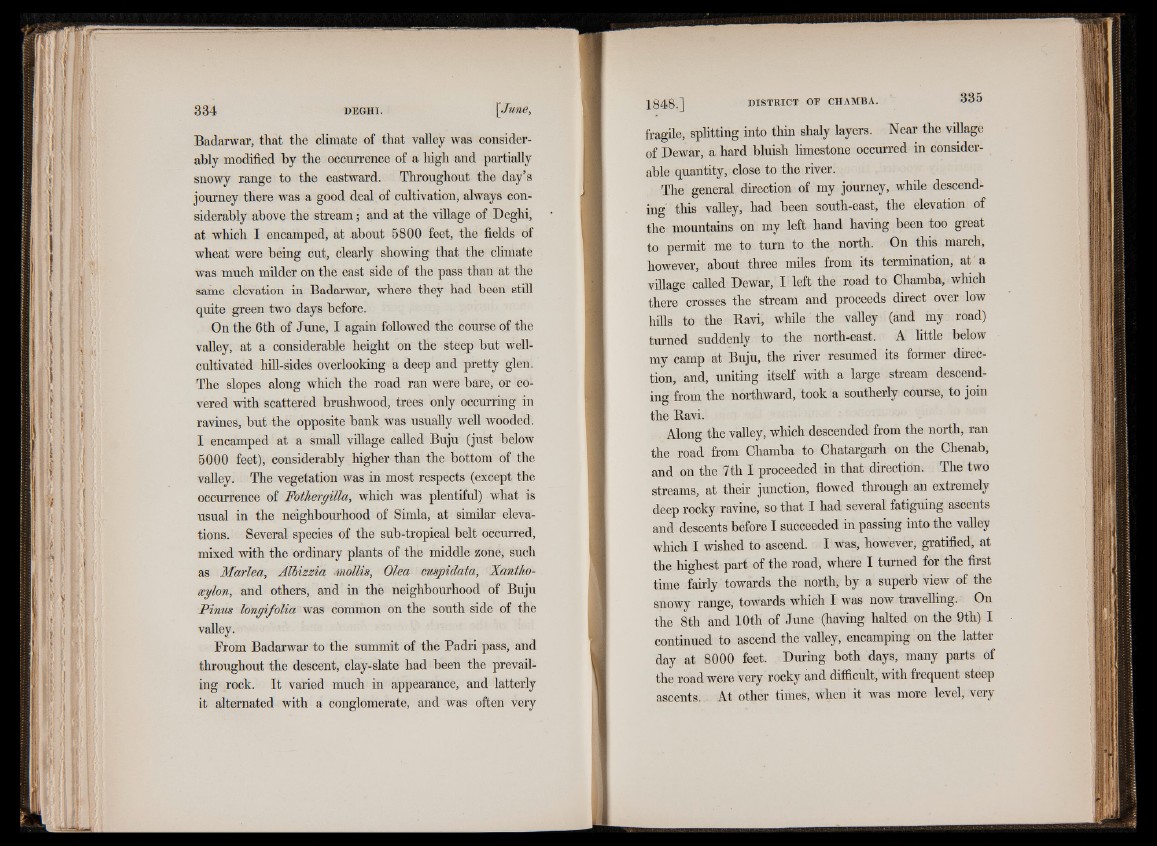
Badarwar, that the climate of that valley was considerably
modified by the occurrence of a high and partially
snowy range to the eastward. Throughout the day’s
journey there was a good deal of cultivation, always considerably
above the stream; and at the village of Deghi,
at which I encamped, at about 5800 feet, the fields of
wheat were being cut, clearly showing that the climate
was much milder on the east side of the pass than at the
same elevation in Badarwar, where they had been still
quite green two days before.
On the 6th of June, I again followed the course of the
valley, at a considerable height on the steep but well-
cultivated hill-sides overlooking a deep and pretty glen.
The slopes along which the road ran were bare, or covered
with scattered brushwood, trees only occurring in
ravines, but the opposite bank was usually well wooded.
I encamped at a small village called Buju (just below
5000 feet), considerably higher than the bottom of the
valley. The vegetation was in most respects (except the
occurrence of Fothergilla, which was plentiful) what is
usual in the neighbourhood of Simla, at similar elevations.
Several species of the sub-tropical belt occurred,
mixed with the ordinary plants of the middle zone, such
as Marlea, Albizzia ■mollis, Olea cuspidata, Xantho-
xylon, and others, and in the neighbourhood of Buju
Pinus longifolia was common on the south side of the
valley.
From Badarwar to the summit of the Padri pass, and
throughout the descent, clay-slate had been the prevailing
rock. It varied much in appearance, and latterly
it alternated with a conglomerate, and was often very
fragile, splitting into thin shaly layers. Near the village
of Dewar, a hard bluish limestone occurred in considerable
quantity, close to the river.
The general direction of my journey, while descending
this valley, had been south-east, the elevation of
the mountains on my left hand having been too great
to permit me to turn to the north. On this march,
however, about three miles from its termination, a t'a
village called Dewar, I left the road to Chamba, which
there crosses the stream and proceeds direct over low
hills to the Bavi, while the valley (and my road)
turned suddenly to the north-east. A little below
my camp at Buju, the river resumed its former direction,
and, uniting itself with a large stream descending
from the northward, took a southerly course, to join
the Ravi.
Along the valley, which descended from the north, ran
the road from Chamba to Chatargarh on the Chenab,
and on the 7th I proceeded in that direction. The two
streams, at their junction, flowed through an extremely
deep rocky ravine, so that I had several fatiguing ascents
and descents before I succeeded in passing into the valley
which I wished to ascend. I was, however, gratified, at
the highest part of the road, where I turned for the first
time fairly towards the north, by a superb view of the
snowy range, towards which I was now travelling. On
the 8th and 10th of June (having halted on the 9th) I
continued to ascend the valley, encamping on the latter
day at 8000 feet. During both days, many parts of
the road were very rocky and difficult, with frequent steep
ascents., At other times, when it was more level, very